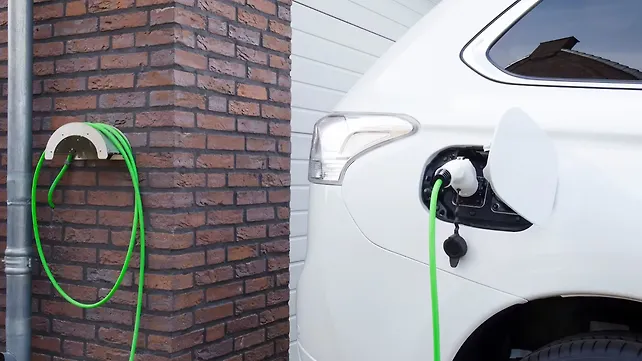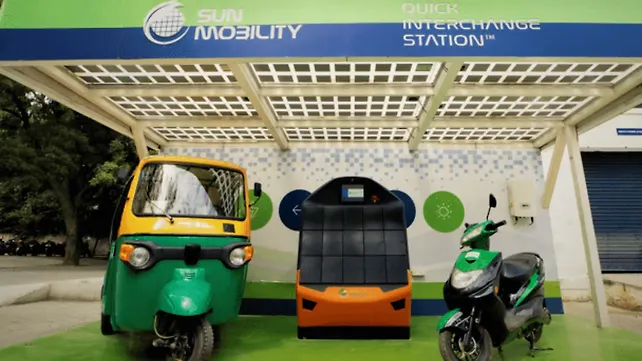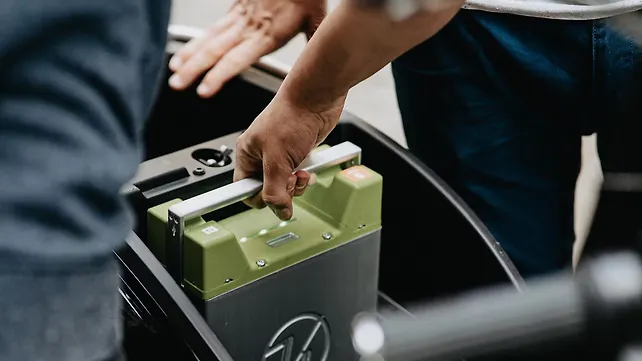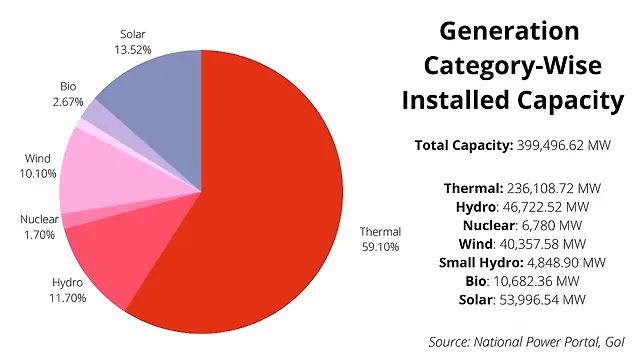
India is on an ambitious plan of running more EVs (electric vehicles) than ICE vehicles on its road by 2030. Now, how much ever it might sound exciting, everything boils down to ‘how’ you ‘power’ them. Especially, when the country continues to face power supply deficit that stood at 0.4% in 2021-22, and legacy issues such as voltage fluctuations, phase imbalance and overloading continue to impact the quality of power output.
“Integration of EVs with the grid is critical for India's EV adoption to accelerate. Charging EV and the grid management would require improved accessibility to the grid, power supply and communication between EV, distribution grid components and the power generation sources,” explained Amit Kumar Sharma, Practice Head, Power, GlobalData.
Utilities need to adopt advanced technical studies, implement effective resource planning and dedicated EV charging programmes to successfully meet the emerging requirements of EV charging, he said.
Currently, EV owners in the country majorly depend upon their household electric power lines for charging. The public EV infrastructure is still at a nascent stage and battery swapping has its own challenges and cannot be a success if the power itself is not supplied effectively.

By 2030, India targets to reach EV sales penetration of 30% for private cars, 70% for commercial cars, 40% for buses, and 80% for two- and three-wheelers. If this is to be achieved, the number of EV charging stations, especially the public charging infrastructure, must grow and that would mean adequate grid preparation to support it.
Currently, the country has less than 2,000 public charging stations that too concentrated primarily in the urban areas.
“As of today, the grids are overloaded and adequate capacity of transformers is not available at the sub-station level, which is the biggest challenge for this entire EV ecosystem. Because of this the infra companies are not able to put up charging infrastructure,” said Shreshth Mishra, Co-Founder, Simple Energy.
Stakeholder Participation
In a bid to increase the EV charging network, the government has allocated a total outlay of INR 1,300 crore under the FAME scheme. It has also proactively amended guidelines for charging infrastructure development in the country to simplify land and electricity procurement, and issued guidance on locations of priority for EV charging infra installation. According to NITI Aayog, the number of public charging stations in India by 2030 is estimated to range from 0.92 million to 1.23 million to support an expected cumulative EV sale of 112-151 million by that time.
The Ministry of Power, meanwhile, has designated Bureau of Energy Efficiency (BEE) as the nodal agency for country-wide rollout of charging infrastructure. BEE has appointed around 25 state-level agencies for setting up EV charging infrastructure at respective states. An email to BEE went unanswered.
Apart from this, several states have also subsidised electricity procurement tariffs for EV charging stations. Tata Power, BSES, BESCOM and NTPC are some of the leading utilities that are setting up EV charging network in India. Other private enterprises that are actively setting EV charging stations include Ather, Ola, SmartE, Fortum and SUN Mobility. Last year, Tata Power reached a milestone of 1,000 EV charging stations across 180 cities in India.

Further, oil marketing companies including IOCL, BPCL and HPCL have also announced installation of 22,000 EV charging stations across the country, including in major cities and along major highways. Metro rail corporations in Delhi and Hyderabad have also joined the bandwagon, joining hands with private entities to roll-out EVs and set-up charging network in their premises.
Highlighting that the government policies are not being implemented at the local DISCOM levels, Mishra said it results in users losing interest in EVs. “DISCOMs don’t have a single-window clearance system, which creates problems for users to get connection for EV chargers. Many such incidents have happened in India,” he said.
There has been a cohesive voice on the fact that EV infrastructure continues to be an urban approach and not seen at a macro country level.
Mishra further added that a few global DISCOMs have adopted AutoGrid platform to integrate various hardware networks. India is very far from that, he said, adding, that it may take a decade to implement such a cloud communication integrated platform in India.
Today, EV chargers/ EVSEs (supply equipment) communicate using OCPP (Open Charge Point Protocol), which is a globally accepted protocol for communication between EVSE and Cloud. “In order to create responsive grids and optimise surge demands, DISCOMs should be accessible through APIs that will create an interface layer between charging infra and grids,” said Mishra.
The government’s push for Smart Grid and its components like advanced power control and protection devices, automated meters, and batteries is in line with the same. It would further make power supply intelligent, predictive, and threat-proof from cyber attacks.
Key Challenges, Opportunities
Speaking on the challenges and opportunities that EV infra poses on conventional power grids, Sharma said utilities or charging point operators need to play a dual role to “meet the needs of their mobility and electricity customers seamlessly, and thus need to ensure right-sized EVSE is installed in desired locations, and matching utility resource plans to EV deployment projections”.
Further, transformers, protection devices and cables that operate at distribution level are usually stressed, added Sharma, when EV charging imposes a peak load on the systems. Also, EV chargers can introduce power quality issues in the distribution grid.
Grounding is another challenge for EV chargers. “Due to the unavailability of proper earthing, EVSEs – being sensitive devices – won't be functional, considering user safety. For that matter, many chargers become offline or non-functional. So, earthing cable is a must for any user to use charging infra,” Mishra stressed.
“The location, design, and power level of expected EVSE projects, investment in grid infrastructure and distribution grid management based on the load, with proper tracking and documentation are typical measures to be undertaken for effective implementation and deployment of EVs,” he said.
Speaking about the augmentation requirements to the grid to support EVs, a spokesperson from Adani Electricity said the company’s grid planning is always futuristic and robust enough to support EV charging and does not need any immediate augmentation to meet the EV demand.
Adani Electricity is planning to launch EV charging infrastructure as a full-fledged service offering to its customers in Mumbai. Currently, it has set-up EV infrastructure at 20 residential societies in Mumbai on a pilot basis and has 50, who have expressed interest.
“As part of this offering, we seek a no objection certificate from the society and invest in the EV infrastructure at a common place within the residential premises,” said the spokesperson, who added that the company is looking at two million units from EVs per year.

Meanwhile, each EV has its own charging requirement in terms of frequency in a week, season and time. Typically, peak EV power demand in cities like Mumbai is seen in the morning and at night. It is more during summers. Interestingly, EV charging also depends on the kind of chargers that are based on power rating and in-built charging technology.
Currently, there are three charging levels that exist internationally – Level 1 AC, Level 2 AC and Level 3 DC Fast Charging. Level 1 chargers are used in residential premises, which usually is a plug-and-play model with a lower power rating. These chargers are usually used during night time. Level 2 chargers have higher power rating up to 20 kW and requires installation by a technician. They are commonly installed in parking lots, retail outlets, malls, and commercial buildings.
Level 3 is fast charging technology, which supplies direct current to the battery without requiring an on-board charger. The power rating of such DC chargers is generally above 200 kW. These fast chargers have the capability to communicate between EV and EV charging stations through communication interfaces. Level 3 chargers are the most expensive and require specialised equipment and installation work.
Alternative Energy Sources
Currently, power generated from non-renewable sources is low-hanging fruit, but solar, wind, and other renewable sources are expected to play a larger role in EV charging infrastructure. “On-site or local power generation from renewable energy can reduce the quantum of electricity required from the grid, reduce grid congestion, and can ultimately result in lower cost of charging,” said Sharma.
A spokesperson from Adani Electricity added, “We are focused on offering renewable energy options to our consumers. We are offering our consumers the flexibility to choose how much renewable energy they want to consume at an extra cost of 66 paise over the current cost. We see this share going up in the coming years and it is playing a crucial role in the EV transition.”
The EV charging infrastructure business is capital intensive and as per ICRA estimates, excluding the land cost, it stands anywhere around INR 29 lakh, without subsidy. The operating costs are seen at over INR 10 lakh per annum, thus making asset utilisation and the adequate power supply to it critical. ICRA expects additional (around) 48,000 chargers over the next three to four years at an investment of around INR 14,000 cr.
Although India remains a laggard in EV charging infrastructure penetration, battery-swapping is an alternative solution instead of developing EV charging infrastructure, especially for commercial applications, said Shamsher Dewan, Vice President and Group Head, ICRA.

“This is also currently in nascent stages in India. Battery swapping is advantageous – it is a quick way of recharging a vehicle and is cost and time efficient. There is increased predictability of battery life due to controlled charging conditions. However, ensuring interoperability, adequate financing availability and maintaining sufficient battery inventory can prove to be challenging,” Dewan said.
Green Measures
At the end of the day, it depends upon the power supply, and therefore, there is no escaping from the fact that the country needs to hasten its efforts towards integrating grid and EV ecosystem. “Moreover, engaging the Green Grid as well,” said an industry expert on the condition of anonymity.
Interestingly, the government is in the process of setting up the Green Energy Corridor (GEC) – Intra-State Transmission System Phase-II scheme. Under this scheme, it aims to facilitate grid integration and set up approximately 20 GW of Renewable Energy (RE) power projects in seven states, namely, Gujarat, Himachal Pradesh, Karnataka, Kerala, Rajasthan, Tamil Nadu and Uttar Pradesh. By 2030, India aims to achieve 450 MW of installed Renewable Energy (RE) power capacity.

As per the latest figures on the National Power Portal (as of May 2022), the total installed capacity stands at 399,496.62 MW (399.5 GW). Of this, solar power makes 13.52%, bio power makes 2.67%, small hydro power makes 1.21%, wind power makes 10.10%, nuclear 1.70% and hydro 11.70%.
In terms of the sector-wise division of installed capacity, central sector holds 25.01%, state sector 26.49% and private sector 48.50%.
In Conclusion
In the integration of grid with EVs, another crucial point is the power fluctuation and ways to mitigate risks related to it. This would require quality EVSEs at charging stations and charging kits that come along with the EVs from OEMs. Since there are many data pointers/ attributes in an EVSE, common software is not possible.
Currently, software like DLMS/ COSEM (or IEC 62056) is the main global standard for smart energy metering, control, and management. In India, IS 16444 standard defines Smart Energy Meter communication from the grid to hardware. Moreover, as per IS 17017-23 and IS 17120 IC-CPD, the charger is designed to handle any sort of surge, leakage, and transient protection.
“The charger has its own protection circuit, which handles grid fluctuation like under voltage or over voltage/current, ground fault detection, leakage current detection, etc.,” Mishra concluded.